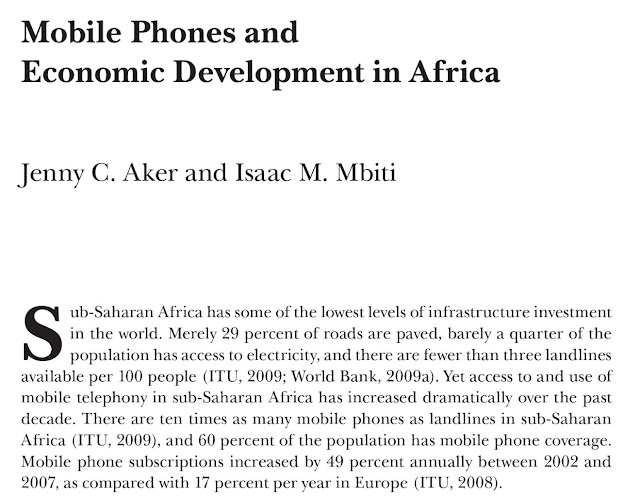In 2013, Statistica reports one hundred and seventy thousand mobile phone towers were operating in Africa.
With 170,000 cell phone towers, Africa leapfrogged the telephone poles and landlines in a decade. Who made that possible? Africa's Tech Sector.
The cost of a new cell phone tower is between $100k ($110k in South America) and $250k (in the USA, where siting and zoning and labor costs are higher). So let's assume the lower range, $100k... times 170,000 African mobile phone towers...
$17 billion dollars worth of mobile phone towers were invested in (many of them "secondhand") on the African continent between 1995 and 2012. What does World Bank say about new cell phones sold to Africans in that period?
Twenty three years ago, a World Bank report said that secondhand equipment was necessary to establish a "critical mass of users" to make telecommunications infrastructure investable. So let's look closely at those mobile phone towers.
The 2010 Tufts University report by Jenny C. Aker and Isaac M. Mbiti was published the same year that "Project Eden" was launched by Interpol, based on the statistic published repeatedly by Basel Action Network - that 80% of the used mobile phones imported by Africans were recycled in "primitive" conditions in "remote fishing villages" like Agbogbloshie.
Mobile phone subscriptions in sub-Saharan Africa increased 49% annually between 2002 and 2007... and in 2011, the Council On Foreign Relations credited the explosion in mass communications to the affordability of used mobile phones.
Interesting that BAN's "80%" statistic was virtually unchanged between 2002 when it first appeared in "Exporting Harm" and when BAN claimed not to be the source to Bloomberg News in 2013. BAN had in the meantime been very, very busy citing their own statistic through the labyrinth of news outlets - citing CNN, citing BBC, citing The Economist, citing USA Today... who we exposed in this blog were all citing BAN.
Meanwhile, paid subscriptions, which paid for the 170k mobile phone towers, were far from static. It's not a great leap of faith to assume that the Africans who paid these subscriptions owned mobile phones - the ones BAN insisted were being burned by children... so in Part 3, we'll explore how many NEW mobile phones would have to be sold in Africa that decade to make $17B in mobile phone towers an investable prospect.
The World Bank, in a report published in 2000, used the phrase "The Critical Mass of Users" to explain how reuse, repair of secondhand electronics was critical to these investments. In Part 3, we'll investigate whether it was remotely possible that Africa's Tech Sector was actually purchasing used mobile phone for scrap value.
There's a crime being committed - defamation of character, and false claims.
The theme of this blog has become the persistent racial profiling of the Tech Sector in emerging markets to the benefit of a Charitable Industrial Complex - BAN, OEMs, and Big Shred. Look in the mirror, my fellow recyclers, when you make claims about what people are doing an ocean away.
PS the photo of Razak Muhammed of Savelugu was taken in 2015 after my first visit to Agbogbloshie. Razak was taking my photo as I was taking a photo of him. He was 22 years old - the same age I was when I took my first full time job in Cameroon, Africa, in 1984.





No comments:
Post a Comment